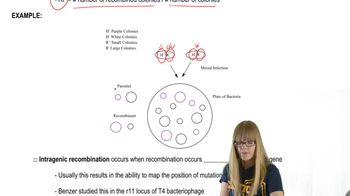Here are the essential concepts you must grasp in order to answer the question correctly.
Bacteriophage Structure and Function
Bacteriophages, or phages, are viruses that infect bacteria. They consist of a protein coat (capsid) that encases their genetic material, which can be either DNA or RNA. Understanding the structure of phages is crucial, as it informs how they interact with host cells and utilize the host's machinery for replication and protein synthesis.
Recommended video:
Transcription and Translation
Transcription is the process by which the genetic information in DNA is copied into messenger RNA (mRNA). Translation follows, where ribosomes synthesize proteins based on the sequence of the mRNA. In the context of phages, while they lack ribosomal genes, they hijack the host's ribosomes to translate their mRNA into proteins necessary for their lifecycle.
Recommended video:
Host Cell Machinery Utilization
Bacteriophages rely on the host bacterial cell's machinery to replicate and produce proteins. Although phages do not encode ribosomal proteins, they exploit the host's ribosomes and other cellular components to synthesize their proteins. This parasitic relationship is fundamental to the phage's ability to propagate within bacterial hosts.
Recommended video:
 Verified step by step guidance
Verified step by step guidance Verified video answer for a similar problem:
Verified video answer for a similar problem:



 3:44m
3:44m